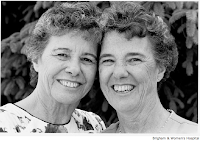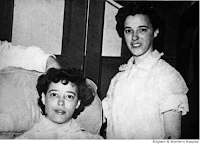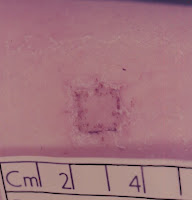Groundbreaking – and lucky to have one
 |
| John Merrill shows the Herrick twins an early dialysis machine |
On December 23rd 1954, 24 year-old Richard Herrick became the first successful kidney transplant recipient in Boston, Massachusetts. He was lucky both to be in Boston, and to have an identical twin brother Ronald who was prepared to take the risk to help him, as at that time the problems of rejection were known but not soluble.
Joseph Murray, the surgeon, had perfected the surgical technique in dogs. The kidney was anastamosed onto the iliac blood vessels in the pelvis outside the peritoneum, as originally developed in France. Much the same operation is used today. Murray had already undertaken 20 transplants of cadaver kidneys into dying patients, usually into the groin and with admission to patients of their experimental nature, but none of them successfully.
The recovery of Richard Herrick’s health, anaemia and nutritional state were remarkable. He died of a heart attack 8 years later, while his genetically identical brother lived 56 years longer until December 2010, perhaps an early pointer to the cardiovascular consequences of kidney disease.

 Edith Helm was 20 and just married in Oklahoma in 1956 when she was told she was dying of renal failure. However she had a twin, Wanda, and later that year travelled to Boston to become the first woman to receive a successful transplant. Before the operation the sisters were visited by Richard Herrick. As she was leaving the hospital in August 1956, she said ‘Ive never been operated on before, never been east before, never been on a plane before. This has really been an experience’ She lived 54 more years until April 2011, going to work as a school cook, and becoming the first transplant patient to give birth, having a son and a daughter.
Edith Helm was 20 and just married in Oklahoma in 1956 when she was told she was dying of renal failure. However she had a twin, Wanda, and later that year travelled to Boston to become the first woman to receive a successful transplant. Before the operation the sisters were visited by Richard Herrick. As she was leaving the hospital in August 1956, she said ‘Ive never been operated on before, never been east before, never been on a plane before. This has really been an experience’ She lived 54 more years until April 2011, going to work as a school cook, and becoming the first transplant patient to give birth, having a son and a daughter.
A total of 12 identical twin grafts had been carried out in Boston by 1961, 35 around the world by 1965. In long term follow-up, 4 of the first 7 died later of renal failure following the recurrence of nephritis in their grafts, in the absence of immunosuppression.
The UK’s first successful transplant was between 49 year old identical twins in October 1960. Means to prove that they were identical are described in detail in Woodruff’s 1961 paper, and were essentially the same as used by Murray and Merrill in Boston, based on appearance, fingerprint patterns (undertaken by local police in Boston), detailed blood grouping, haptoglobin variants, and finally on skin grafting. A square of skin was taken from each twin and transplanted to the other. This proof of immunological identity and tolerance between identical twins was first demonstrated in 1937.
 |
| Reciprocal skin grafts between the Edinburgh identical twin brothers |
Skin grafts like this were used to prove tolerance between a pair of non-identical (male and female) twins who had exchanged some bone marrow in utero. Very unusually their blood showed two blood types: the man had 86% group A red cells and 14% group O, while the woman had 99% O and 1% A. The skin grafts were not rejected (Woodruff 1959). This provided evidence that tolerance might be achievable without drugs one day. Experience in twins suggests it could be at the expense of a higher incidence of disease recurrence.
Many different approaches to suppressing rejection were investigated in these early days and modern regimens were arrived at step by step, with azathioprine being the first key success after the failure of irradiation treatment.
Further reading
Murray JE, MP Merrill, JH Harrison. Renal homotransplantation in identical twins. J Am Soc Nephrol 12:201-4 (reprinted from Surg Forum 1955 VI: 432-6)
Woodruff MFA, JS Robson, JA Ross, B Nolan, AT Lambie. Transplantation of a kidney from an identical twin. Lancet 1961 ii 1245-9
Murray JE. Human organ transplantation: background and consequences. (from Nobel Prize Lecture 1990). Science 1992 256:1411-15
Woodruff MFA, B Lennox. Reciprocal skin grafts in a pari of twins showing blood chimaerism. Lancet 1959 ii 476-8
Tilney NL. Renal transplantation between identical twins: a review. World J Surg 1986 10:381-8

One response to “Twins in transplantation”
Triplets: Roy Calne and Peter Friend, Lancet 1997 350:1077. Intestinal transplants from one identical triplet to another, no immunosuppression. All were predisposed to thrombosis, making the exercise a bit scary.